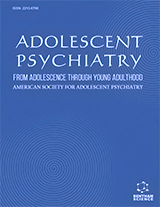Abstract
Background: At a time when suicides are increasing throughout the United States, lesbian, gay, bisexual, transgender, and two-spirit (LGBTQ2S) adolescents are at especially high risk for suicidal ideation, attempts, and completed suicide.
Objectives: This study aimed to 1) provide an overview and clinical perspective on LGBTQ2S suicidal ideation, attempts, and completed suicide, 2) discuss how the literature maps on to theories of suicide and also point the way to clinical recommendations, and 3) give recommendations for clinical care based on this evidence.
Methods: This article uses a narrative review style to discuss the current concerns regarding LGBTQ2S adolescent suicide. The Social Ecological Model, the Interpersonal Psychological Theory of Suicide, and Minority Stress Theory are used to describe the manner in which risks are acquired.
Results: Emerging research demonstrates risks and protective factors in the lives of LGBTQ2S adolescents. The social context of LGBTQ2S adolescents puts them at risk for internalizing the experiences of discrimination evident in our society. In addition, there are other risk factors frequently associated with their LGBTQ2S status, such as substance misuse, homelessness, and lack of social support. Adolescents of color are especially vulnerable as they experience multiple marginalizations, often living in under-resourced communities with poor access to health care. Support to families can be provided in the form of psychoeducation based on research findings. Social support is crucial and can be effectively provided in schools. Access to mental health care needs to be increased, and barriers must be reduced.
Conclusion: There is a need for more research, especially prospective study designs and research that centers on adolescents of color and homeless adolescents. While there may be barriers to addressing the current rate of suicidality in this population, clinicians who work with adolescents can use a range of therapies to support their LGBTQ2S adolescent patients and their families, decreasing the risk of suicidality.
Keywords: Adolescents, gay, LGBTQ2S, lesbian, suicidality, suicide, transgender, two spirit
Adolescent Psychiatry
Title:Lesbian Gay Bisexual Transgender Questioning/Queer Two- Spirit Adolescents and Suicidality
Volume: 12 Issue: 3
Author(s): Valerie Tobin, Neeral K. Sheth*, Hale M. Thompson and Niranjan S. Karnik
Affiliation:
- Department of Psychiatry & Behavioral Sciences, Rush Medical College, Rush University, Chicago, IL, USA
Keywords: Adolescents, gay, LGBTQ2S, lesbian, suicidality, suicide, transgender, two spirit
Abstract:
Background: At a time when suicides are increasing throughout the United States, lesbian, gay, bisexual, transgender, and two-spirit (LGBTQ2S) adolescents are at especially high risk for suicidal ideation, attempts, and completed suicide.
Objectives: This study aimed to 1) provide an overview and clinical perspective on LGBTQ2S suicidal ideation, attempts, and completed suicide, 2) discuss how the literature maps on to theories of suicide and also point the way to clinical recommendations, and 3) give recommendations for clinical care based on this evidence.
Methods: This article uses a narrative review style to discuss the current concerns regarding LGBTQ2S adolescent suicide. The Social Ecological Model, the Interpersonal Psychological Theory of Suicide, and Minority Stress Theory are used to describe the manner in which risks are acquired.
Results: Emerging research demonstrates risks and protective factors in the lives of LGBTQ2S adolescents. The social context of LGBTQ2S adolescents puts them at risk for internalizing the experiences of discrimination evident in our society. In addition, there are other risk factors frequently associated with their LGBTQ2S status, such as substance misuse, homelessness, and lack of social support. Adolescents of color are especially vulnerable as they experience multiple marginalizations, often living in under-resourced communities with poor access to health care. Support to families can be provided in the form of psychoeducation based on research findings. Social support is crucial and can be effectively provided in schools. Access to mental health care needs to be increased, and barriers must be reduced.
Conclusion: There is a need for more research, especially prospective study designs and research that centers on adolescents of color and homeless adolescents. While there may be barriers to addressing the current rate of suicidality in this population, clinicians who work with adolescents can use a range of therapies to support their LGBTQ2S adolescent patients and their families, decreasing the risk of suicidality.
Export Options
About this article
Cite this article as:
Tobin Valerie, Sheth K. Neeral*, Thompson M. Hale and Karnik S. Niranjan, Lesbian Gay Bisexual Transgender Questioning/Queer Two- Spirit Adolescents and Suicidality, Adolescent Psychiatry 2022; 12 (3) . https://dx.doi.org/10.2174/2210676612666220826142153
| DOI https://dx.doi.org/10.2174/2210676612666220826142153 |
Print ISSN 2210-6766 |
| Publisher Name Bentham Science Publisher |
Online ISSN 2210-6774 |
 4
4
- Author Guidelines
- Bentham Author Support Services (BASS)
- Graphical Abstracts
- Fabricating and Stating False Information
- Research Misconduct
- Post Publication Discussions and Corrections
- Publishing Ethics and Rectitude
- Increase Visibility of Your Article
- Archiving Policies
- Peer Review Workflow
- Order Your Article Before Print
- Promote Your Article
- Manuscript Transfer Facility
- Editorial Policies
- Allegations from Whistleblowers
- Announcements


























